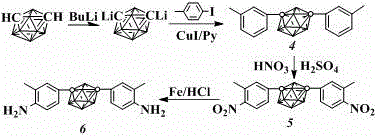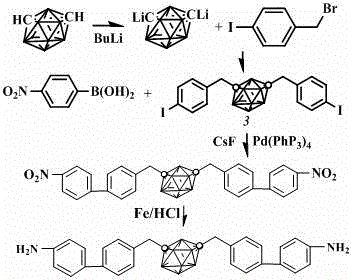Method for preparing ultra-high heat resistant polyimide polymer
A polyimide, heat-resistant technology, applied in the chemical field, can solve the problems of the final polymer's solubility degradation, hindering material processing and recycling, etc.
- Summary
- Abstract
- Description
- Claims
- Application Information
AI Technical Summary
Problems solved by technology
Method used
Image
Examples
Embodiment 1
[0028] Synthesis of 1,7-bis-aniline-m-carborane
[0029] Weigh 1.0 g of 1,7-bis-phenyl-m-carborane, dissolve it in 50 mL of dichloromethane, and place the reaction system in an ice bath to cool. Then slowly add a mixture of 5mL nitric acid and 25mL concentrated sulfuric acid. The resulting mixture was stirred and reacted at room temperature for 15 hours. After the reaction was completed, the acid layer was discarded, and the organic phase was washed with saturated sodium carbonate solution and then with deionized water. The organic phase after layering is dried with anhydrous magnesium sulfate, and magnesium sulfate is filtered off after drying, and a light yellow solid is obtained after vacuum distillation, and the synthetic route diagram is as follows: figure 1 shown.
[0030] The obtained pre-yellow solid was dissolved in 50 mL of ethanol, heated to reflux, and then 0.68 g of reduced iron powder and 4 mL of concentrated hydrochloric acid were added. After completion, th...
Embodiment 2
[0035] Synthesis of 1,7-bis-(3-methyl-4-nitrophenyl)-m-carborane
[0036] Weigh 0.8g of 1,7-bis-phenyl-m-carborane, dissolve it in 50mL of dichloromethane, and place the reaction system in an ice bath to cool. Then slowly add a mixture of 5mL nitric acid and 25mL concentrated sulfuric acid. The resulting mixture was stirred and reacted at room temperature for 15 hours. After the reaction was completed, the acid layer was discarded, and the organic phase was washed with saturated sodium carbonate solution and then with deionized water. The stratified organic phase was dried with anhydrous magnesium sulfate, and the magnesium sulfate was filtered off after drying, and a light yellow solid was obtained after vacuum distillation. The resulting pale yellow solid is crystallized from a mixed solution of ethyl acetate and petroleum ether to obtain the product, and the synthetic route diagram is as follows: figure 2 shown.
[0037] 1 H NMR (400MHz, DMSO) δ8.09 (d, J = 2.1Hz, 4H)...
Embodiment 3
[0045] Synthesis of 1,7-bis-[4-(3-nitrophenyl)-benzyl]-m-carborane
[0046] Weigh 0.5 g of 1,7-bis-(3-iodobenzyl)-m-carborane and 0.79 g of cesium fluoride and dissolve it in 50 mL of dry DME, and bubble the resulting suspension with argon for 20 minutes to remove solids. system air. Then add 0.10g Pd(PPh 3 ) 4 , the reaction mixture was stirred at 80° C. for 16 h under nitrogen atmosphere. The collected supernatant was evaporated and dried under reduced pressure to obtain a yellow oily product. The obtained oil was dissolved in ethyl acetate and separated by column chromatography. The eluent was ethyl acetate / petroleum ether (1 / 4) mixed solution.
[0047] 1 H NMR (400MHz, DMSO) δ8.38 (t, J = 2.0Hz, 2H), 8.19 (ddd, J = 8.2, 2.2, 0.7Hz, 2H), 8.11 (dd, J = 4.7, 3.7Hz, 2H) , 7.74(d, J=1.8Hz, 2H), 7.71(d, J=1.6Hz, 4H), 7.24(d, J=8.2Hz, 4H), 2.31-1.30(br s, 10H). 13 C NMR(101MHz,DMSO)δ148.83,141.61,137.85,137.21,133.51,131.10,130.90,127.28,122.59,121.35,77.06,41.62.IR(KBr):2...
PUM
 Login to View More
Login to View More Abstract
Description
Claims
Application Information
 Login to View More
Login to View More - R&D
- Intellectual Property
- Life Sciences
- Materials
- Tech Scout
- Unparalleled Data Quality
- Higher Quality Content
- 60% Fewer Hallucinations
Browse by: Latest US Patents, China's latest patents, Technical Efficacy Thesaurus, Application Domain, Technology Topic, Popular Technical Reports.
© 2025 PatSnap. All rights reserved.Legal|Privacy policy|Modern Slavery Act Transparency Statement|Sitemap|About US| Contact US: help@patsnap.com



